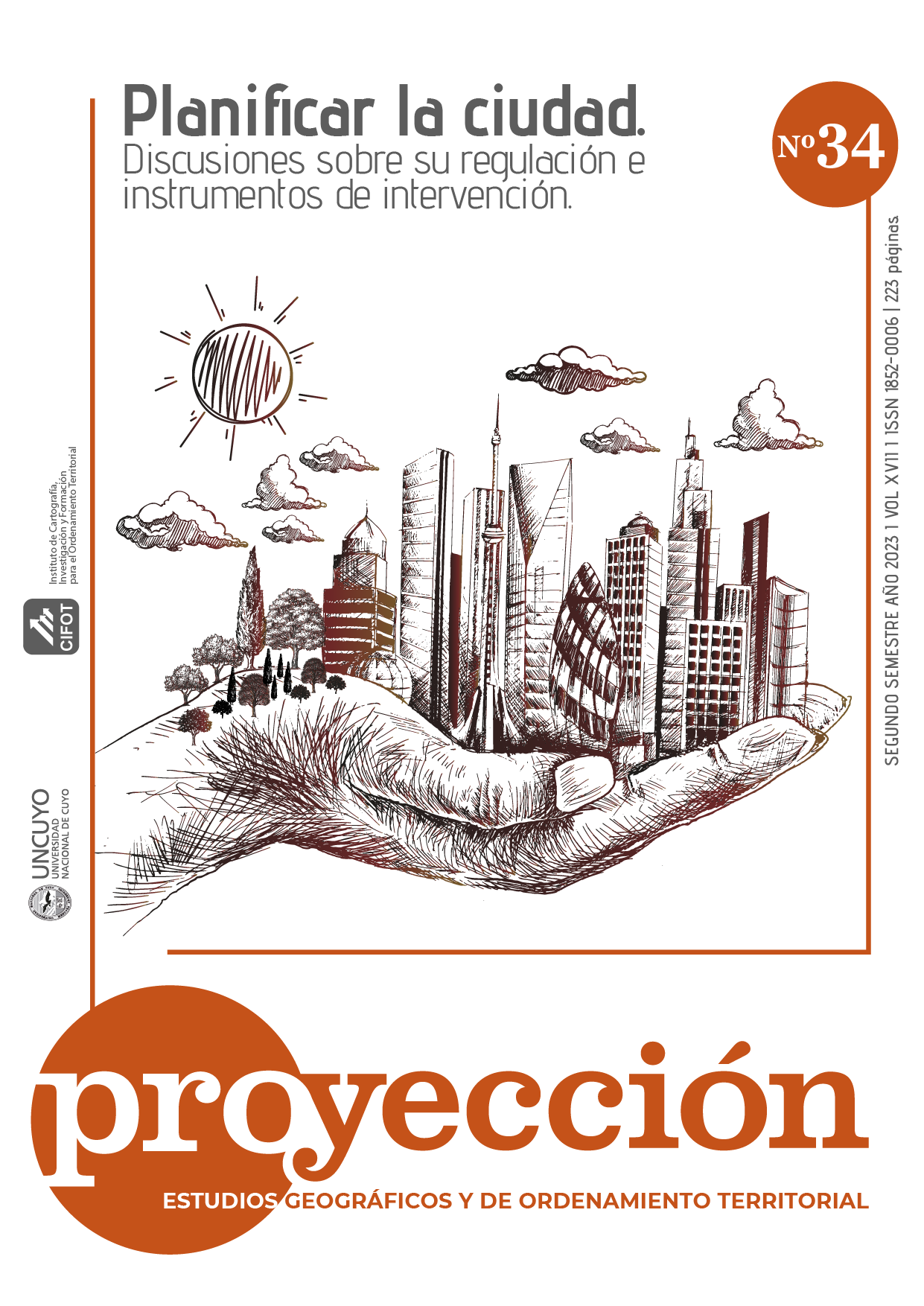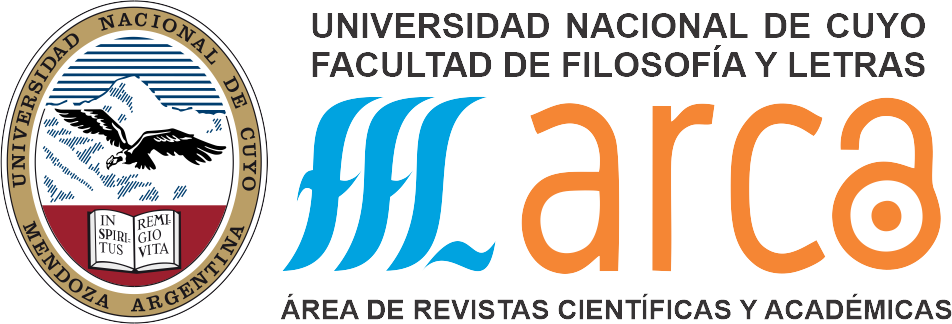Edge spaces and normative development from an integral perspective
experience of the Nuevo Alberdi neighborhood (Rosario, Argentina)
DOI:
https://doi.org/10.48162/rev.55.045Keywords:
peri-urban areas, planning, environmental managementAbstract
Urban-rural fringe spaces have been subject to profound transformations in recent decades. They are characterized by the coexistence of different uses and are subject to different interests that generate socio-environmental disputes and conflicts. Likewise, they are often distinguished by lax, fragmented and outdated regulations in the face of the complex processes they are undergoing, deepening existing problems. Taking as a case study the Nuevo Alberdi neighborhood, located in the northern interface area of Rosario, we propose to contribute to the knowledge of the normative development from an integral perspective of habitat from the processes of transformation of the territory, the role of social movements and the participation of local actors in defense of the rights to access to land and a sustainable environment. A qualitative methodology was used to analyze the territorial transformations that have taken place, as well as the urban-territorial planning and management instruments in the sector over the last twenty years. The particular study of the Nuevo Alberdi case is a contribution to the contemporary debate on the effective management and regulation of edge territories and their importance in the sustainable development of cities and regions.
References
Allen, A. (2003). Environmental planning and management of the peri-urban interface: perspectives on an emerging field. Environment&Urbanization(1), 135-148. doi:10.1177/095624780301500103
Ávila Sánchez, H. (2009). Periurbanización y espacios rurales en la periferia de las ciudades. Estudios agrarios, 15(41), 93-123.
Barenboim, C. A. (2010). Dinámica inmobiliaria en la ciudad de Rosario (Período 1998 – 2009). Proyección 8.
Barenboim, C., & Zamler, D. (2017). Impacto socioambiental en la creación de nuevas áreas urbanas en la ciudad de Rosario, Argentina: 2005-2017. Ciudades, Estados y Política, 4(2), 51-66.
Barsky, A. (2005). El periurbano productivo, un espacio en constante transformación. Introducción al estado del debate, con referencias al caso de Buenos Aires. Scripta Nova. Revista Electrónica de Geografía y Ciencias Sociales, IX, 194(36). Retrieved from https://www.ub.edu/geocrit/sn/sn-194-36.htm
Bauer, G., & Roux, J. (2022). Rurbanisation (1976). In The Horizontal Metropolis: The Anthology (pp. 247-259). Cham: Springer International Publishing.
Bracalenti, L., Copello, S., Falbo, E., Godoy Garraza, G., González, E., Lagorio, L., . . . Terrile, R. (2012). Agricultura familiar y acceso a la tierra urbana y periurbana: Marco normativo y estrategias jurídicas. INTA.
Brook, R. M., & Dávila, J. (2000). The Peri-Urban Interface: a Tale of Two Cities. University of Wales and Development Planning Unit, University College London.
Buxton, M., & Butt, A. (2018). The future of the fringe: The crisis in peri-urban planning. CSIRO PUBLISHING.
Cardoso, M. M. (2020). El tercer territorio en los estudios latinoamericanos: Redefinición de las categorías teóricas socio-espaciales. Párrafos Geográficos, 19(1). Retrieved from https://ri.conicet.gov.ar/bitstream/handle/11336/174255/CONICET_Digital_Nro.148f0576-e82e
Club de Investigaciones Urbanas. (2013). Rosario arde, a pura adrenalina arde.
Corner, J. (2006). Terra Fluxus. In W. Charles, & C. Waldheim (Ed.), The landscape urbanism reader (pp. 21-32). Nueva York: Princeton Architectural Press.
Diez Medina, C., Ezquerra, I., Monclús Fraga, J., Pierini, O., Sucena, S., & Ioannou, O. (2022). Áreas periurbanas en transformación. Estrategias para la resiliencia de los paisajes periurbanos en ciudades europeas y españolas. Cuadernos de Investigación Urbanística (142), 167-184. doi:10.20868/ciur.2022.142.4893
Folch, R. (2003). Los conceptos socioecológicos de partida. In R. Folch (Coord), El territorio como sistema: conceptos y herramientas de ordenación (pp. 19-42). Diputació de Barcelona.
Folch, R. (2017). Las funciones sistémicas del paisaje mediterráneo. Quaderns de la Mediterrània, 25, 219.
Forman, R. T. (2014). Land Mosaics: The ecology of landscapes and regions. In The ecological design and planning reader (pp. 217-234).
Galimberti, C. I. (2016). Paisajes entre-ciudades. Transformaciones contemporáneas de la interfase urbano-rural. A&P Continuidad, 5(3), 148-159.
Galimberti, C. I. (2017). Transformaciones del frente territorial del Gran Rosario: estrategias, proyectos e intervenciones (siglos XIX-XXI). Anales del IAA, 47(1), 67-82.
Galimberti, C., & Ciarniello, L. (2023). Debates en Torno a la Crisis Ambiental y al Neoextractivismo Agrícola. Historia y Posibles Alternativas de las Tensiones en los Paisajes Intermedios en el Gran Rosario (Argentina). Historia Ambiental Latinoamericana Y Caribeña (HALAC) Revista De La Solcha, 13(2), 215-247. Retrieved from https://doi.org/10.32991/2237-2717.2023v13i2.p215-247
Garreau, J. (1992). Edge City. Life on the New Frontier. Knopf Doubleday Publishing Group.
IGC. (2021). Urbanización Nuevo Alberdi. ¿Será que esta vez será?
IGC. (2023, Julio 14). Retrieved from www.igc.org.ar/nuevoalberdi
Lang, R. E. (2003). Edgeless cities: Exploring the elusive metropolis. Brookings Institution Press.
Morello, J. (2000). Funciones del sistema periurbano: el caso de Buenos Aires. Mar del Plata: Universidad Nacional de Mar del Plata-Ediciones CIAM/GADU.
Mosconi Frey, C. (2018). Figuras de protección urbano-rural. Aportes para la interpretación de áreas periurbanas inundables: el caso de Nuevo Alberdi Oeste Rural, Rosario-Argentina. Valparaíso.
Municipalidad de Rosario. (1987). Jornadas de Divulgación sobre ordenamiento urbano y aspectos ferroportuarios de la ciudad de Rosario. Rosario: Secretaría de Planeamiento.
Municipalidad de Rosario. (1991). Actualización del Plan Regulador y Bases Documentales para la revisión del Código Urbano. Tomo I y II. Rosario: Secretaría de Planeamiento.
Municipalidad de Rosario. (1999). Nuevo Plan Director, Bases para el Acuerdo. Rosario: Secretaría de Planeamiento.
Municipalidad de Rosario. (2011). Libro PUR: Plan Urbano Rosario 2007-2017. Rosario: Secretaría de Planeamiento.
Municipalidad de Rosario. (2021). Ordenanza Municipal N° 10231. Plan Especial Urbano Ambiental Canales Ibarlucea y Salvat.
RENABAP. (2022). Factores de riesgo en barrios populares del Gran Buenos Aires.
Rolnik, R. (2018). La guerra de los lugares: La colonización de la tierra y la vivienda en la era de las finanzas. LOM ediciones.
Secchi, B. (1984). Le condizioni sono cambiate. Casabella: Archittetura come modificazione, 498/9.
Sieverts, T. (2003). Cities without cities: an interpretation of the Zwischenstadt. Routledge.
Smith, T. (1937). The Population of Louisiana: Its Composition and Changes. Louisiana State University and Agricultural and Mechanical College, Agricultural Experiment Station.
Svampa, M. (2001). Los que ganaron. La vida en los countries y barrios privados. Editorial Biblos.
Svampa, M. (2005). La sociedad excluyente: La Argentina bajo el signo del neoliberalismo. Buenos Aires: Taurus.
Svampa, M., & Viale, E. (2017). Continuidad y radicalización del neoextractivismo en la Argentina. Voces en el Fénix, 60, 26-35. Retrieved from https://vocesenelfenix.economicas.uba.ar/continuidad-y-radicalizacion-del-neoextractivismo-en-la-argentina/
Wehrwein, G. S. (1942). The rural-urban fringe. Economic Geography, 18(3), 217-228.
Whitehand, J. W. (1967). Fringe belts: a neglected aspect of urban geography. Transactions of the Institute of British Geographers, 223-233.
Downloads
Published
How to Cite
Issue
Section
License
Copyright (c) 2023 Laura Ciarniello, Evangelina Gómez, Cecilia Galimberti

This work is licensed under a Creative Commons Attribution-NonCommercial-ShareAlike 3.0 Unported License.
La revista Proyección establece las siguientes condiciones de publicación para los/as autores/as:
- Los/as autores/as conservan los derechos de autor y ceden a la revista el derecho de publicación bajo la Licencia Creative Commons Atribución-No Comercial-CompartirIgual 3.0 No portada (CC BY-NC-SA 3.0) que permite a terceros copiar, distribuir, exhibir y ejecutar la obra citando siempre la fuente y los datos de autoría según la norma prevista por la Revista Proyección. Esta licencia no permite el uso de la obra con fines comerciales.
- Todos los trabajos publicados por Proyección, Estudios Geográficos y de Ordenamiento Territorial serán bajo la modalidad de gratuidad para autores/as y lectores/as.










